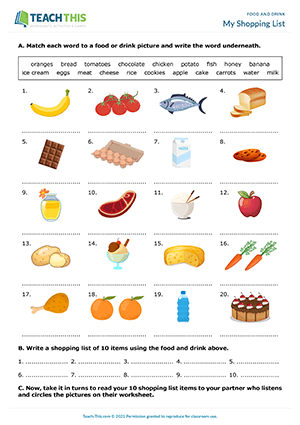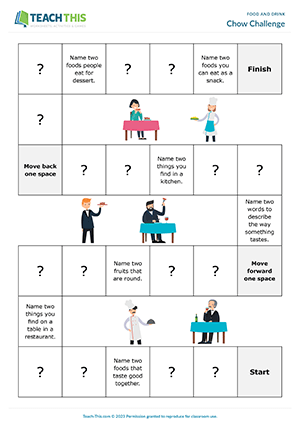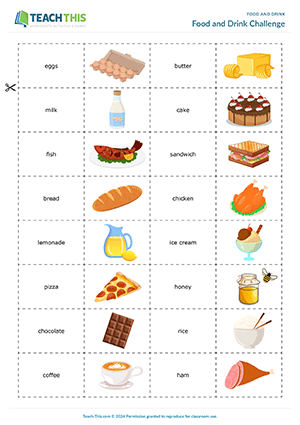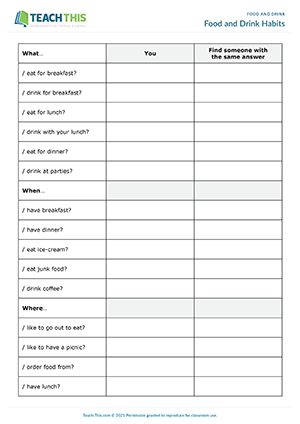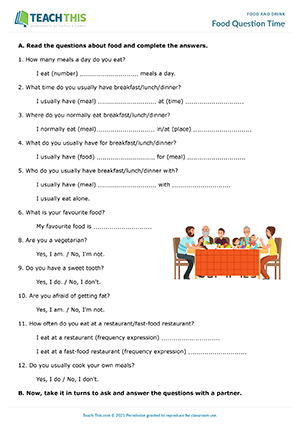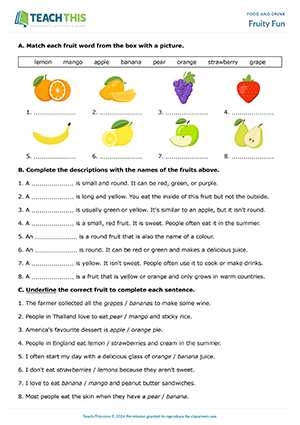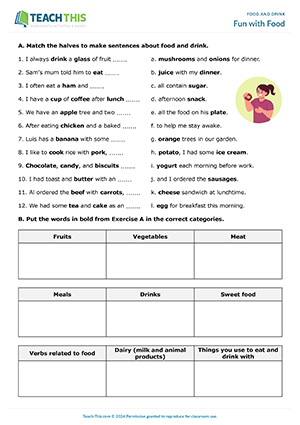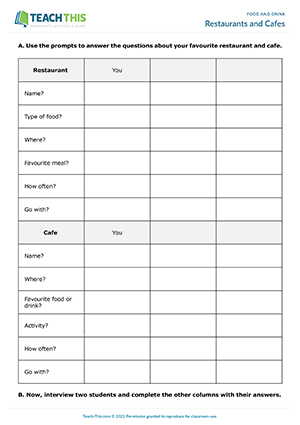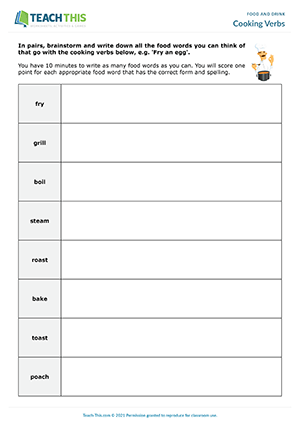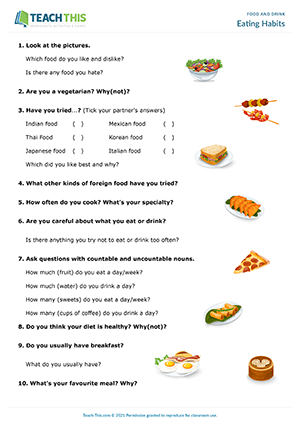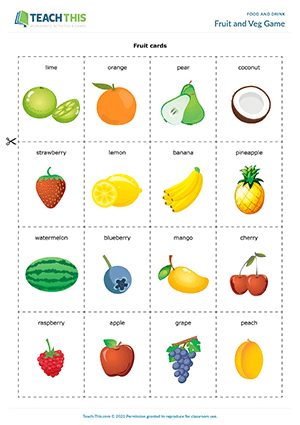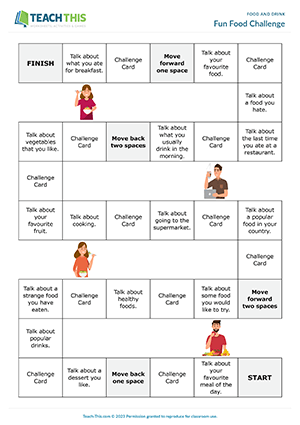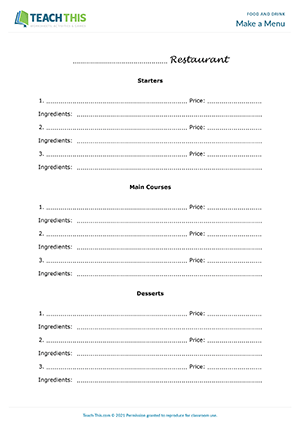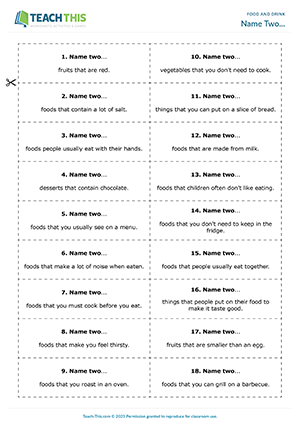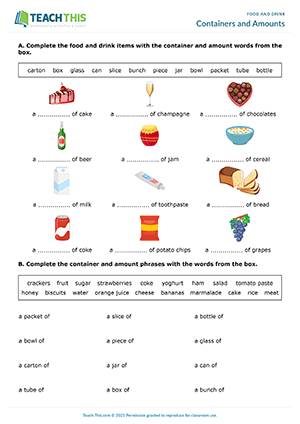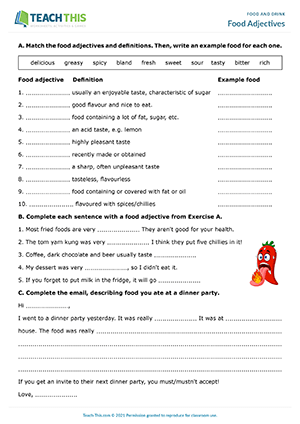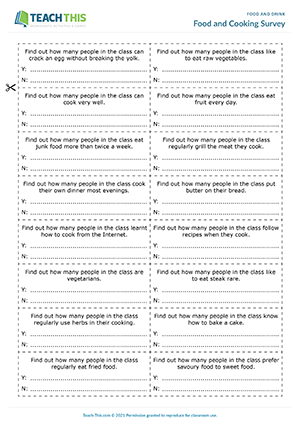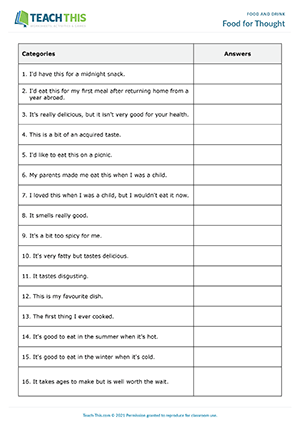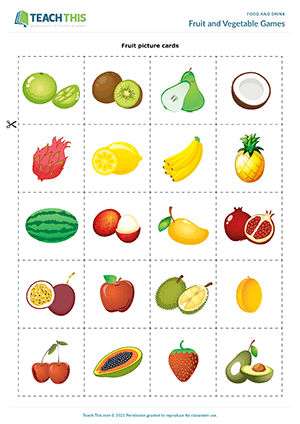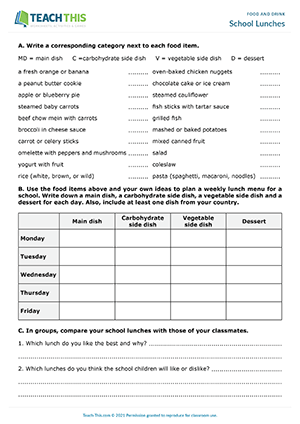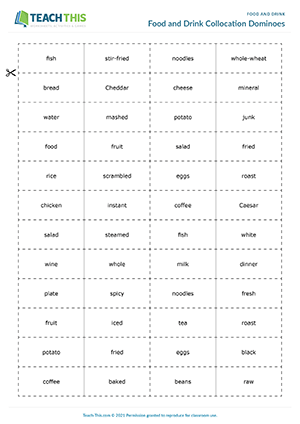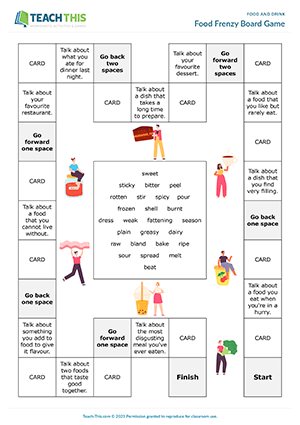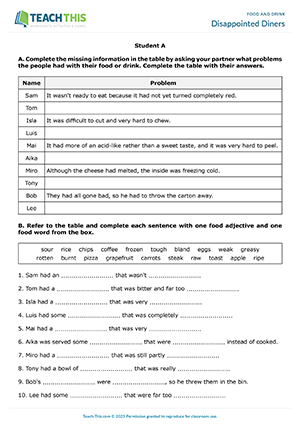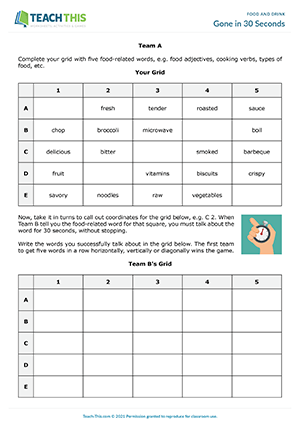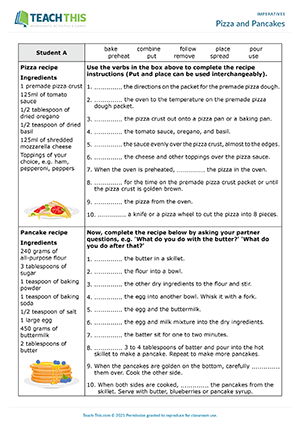In this free food and drink vocabulary activity, students match food and drink words to pictures and review the vocabulary in a dictation game. First, students match each word to a food and drink picture and write the word underneath. Students then write a shopping list of 10 items using the food and drink. Next, in pairs, students take it in turns to say 'This is my shopping list. Circle the food and drink items I say'. The student then reads their 10 shopping list items to their partner who listens and circles the corresponding pictures on their worksheet. Students score a point for each correct food or drink item they circle. The student with the most points wins.
Here is an engaging food and drink board game to help students practice a variety of vocabulary related to food and drink. Players take turns rolling the dice and moving their counters along the board. If a player lands on a question mark square, another student picks up a card and reads out the food-related question on the card along with three possible answers. The player then chooses an answer. If the answer is correct, the player stays on the square. If not, the player moves their counter back two squares. If a player lands on a 'Name two' square, they have ten seconds to name two food-related things that match the description. If a player doesn't complete the task, they go back two squares. It's then the next student's turn to play. The first player to reach the finish wins the game.
Here are two food and drink games to help students practice the names of common foods and drinks. First, students play a pelmanism game where they match the names of common foods and drinks to pictures. First, in pairs, students take turns turning over one food or drink word card and one picture card. If the food or drink word matches with the picture, the student keeps the two cards and has another turn. If the two cards don't match, the student turns them back over. The student with the most pairs of cards at the end of the game wins. Next, students play a true or false game using the picture cards. With a new partner, students take turns picking up a picture card and making a true or false statement about the food or drink on the card, e.g. 'I drink juice every morning.' The other student then guesses whether the statement is true or false. Students score one point for each correct guess. The student with the most points at the end of the game wins.
In this insightful eating habits speaking activity, students ask and answer present simple questions about eating and drinking habits. Students start by reviewing prompts on the worksheet and forming the present simple questions they need to ask to do the activity, e.g. 'What do you usually eat for breakfast?' Students then answer the questions and write down their answers. Next, students go around the class asking and answering the questions to find people with the same answers. When a student finds someone with the same answer, the two students write down each other's names. Finally, students give feedback to the rest of the class on what they found out.
In this productive eating habits speaking activity, students ask and answer food-related questions. Working alone, students read questions about food on the worksheet and complete the answers by writing in the spaces provided. In pairs, students then take it in turns to ask and answer the questions with their partner. Afterwards, students report back to the class on their partner's answers.
Here is a comprehensive fruit worksheet to help students learn and practice fruit vocabulary. First, students match fruit words from a box with pictures. Students then complete descriptions with the fruit vocabulary. Next, students underline the correct fruit to complete each sentence. After that, students complete facts by choosing the correct fruit. Students then rank eight fruits from their most to least favourite and compare their rankings with a partner. Finally, in pairs, students answer each question with a fruit from the previous exercise.
This detailed food and drink worksheet helps students practice vocabulary related to food and drink. First, students match halves to make sentences about food and drink. Students then put words in bold from the sentences in the correct categories. Next, students underline the correct food words in sentences. After that, students complete food and drink questions with words from a box. Lastly, students ask and answer the questions with a partner.
In this engaging eating out speaking activity, students ask and answer questions about their favourite restaurants and cafes. To begin, students go through the prompts on the worksheet and form the questions they need for the activity. Students then use the prompts to answer questions about their favourite restaurant and cafe. When the students have finished, they interview two classmates and complete the worksheet with their answers. Afterwards, students report back to the class on what they found out.
This handy cooking verbs game is ideal for practicing verbs related to cooking and food vocabulary. In pairs, students have ten minutes to brainstorm and write down all the food words they can think of that go with the cooking verbs on the worksheet, e.g. 'fry an egg'. Pairs score one point for each appropriate food word that has the correct form and spelling. The pair with the most points wins the game.
In this free eating habits questionnaire, students ask and answer questions about eating habits. In pairs, students take it in turns to ask and answer questions about eating habits and write their partner's answers on the worksheet. When the students have finished, they report back to the class on their partner's eating habits.
In this enjoyable fruit and vegetables game, students describe fruit and vegetables for other students to guess. In groups, students take it in turns to pick up a card and describe the fruit or vegetable on the card to the other students in the group. The student describing begins by saying whether the item on the card is a fruit or vegetable. The student then goes on to describe what it looks like, tastes like, what it's used for or in, etc. The other students listen and try to guess the fruit or vegetable. The first student to guess correctly wins and keeps the card. The student with the most cards at the end of the game is the winner.
In this fun food and drink board game, students practice talking about food and drink using topic-related vocabulary. Players take turns rolling the dice and moving their counters along the board. If a player lands on a 'Talk about' square, they talk about the food topic on the square for 20 seconds without stopping. If a player can't think of anything to say or stops talking before the 20 seconds are up, they go back two squares. If a player lands on a 'Challenge Card' square, another student picks up a card and reads out the challenge. The player has ten seconds to answer. If the other students agree that the player's answer is appropriate, the player stays on the square. If the player is unable to complete the challenge or the group decides that the player's answer is not appropriate, they move their counter back two squares. The first player to reach the finish wins the game.
In this imaginative menu worksheet, students create a restaurant menu, showing dishes they like to eat along with the price and ingredients of each dish. Students start by thinking of a name for their restaurant and writing it at the top of the menu. Students then complete the rest of the menu with dishes they like to eat. Students write the name of each dish as well as the price and a description of the ingredients. When the students have finished, they talk about their menus in front of the class. As an extension, students role-play a restaurant dialogue using the menus.
In this fun food and drink game, students race to name food and drink vocabulary that matches 'Name two...' prompts. In groups, students take turns picking up a card and reading the 'Name two...' prompt to the other students, e.g. 'Name two fruits that are red.' The other students then race to name two food or drink-related items that match the prompt. The first student to put up their hand gets to answer. If the student answers correctly, they win and keep the card. If not, the other students can put up their hands and answer. The student with the most cards at the end of the game wins. Afterwards, review the students' answers together as a class.
This free containers and amounts worksheet helps you to teach your students about containers and amounts that go with food and drink items. Students begin by completing food and drink items with container and amount words from a box on the worksheet. After that, students complete container and amount phrases with food and drink vocabulary.
In this comprehensive food adjectives worksheet, students learn about food adjectives and write an email, describing food at a dinner party. Students begin by matching food adjectives with definitions and writing an example food for each one. Next, students complete a set of sentences with the food adjectives. After that, students write an email to a friend, describing food they ate at a dinner party using the food adjectives to describe whether the food was good or bad. Afterwards, students read a partner's email and give feedback.
In this interesting food and cooking speaking activity, students conduct a survey where they ask and answer yes/no questions about eating and cooking habits. The students' task is to find out the information on a card by asking each student in the class a yes/no question, e.g. 'Do you like to eat raw vegetables?' Students make a note of the number of people who answer yes or no to their question on the card. When everyone has finished, each student reports back to the class on their findings. This can then lead on to a further discussion about the eating and cooking habits of the class.
In this useful food discussion activity, students write about and discuss types of food and dishes. First, students read the categories on the worksheet and write an example of a food or dish for each one. In groups, students then discuss each category in turn and explain their answers to each other. Students ask follow-up questions and develop a short discussion about each topic. When the groups have finished, there is a class feedback session to discuss the students' answers.
These free fruit and vegetable games help students learn the names of fruit and vegetables. To begin, students play a pelmanism game where they take it in turns to turn over a vocabulary card and a picture card. If the word matches with the picture of the fruit or vegetable, the student scores a point. The student then writes the name of the fruit or vegetable on the back of the picture card, keeps it and has another turn. Afterwards, students put all the picture cards face up on the table and divide them into two sets: fruit and vegetables. Students then see if they can remember the names of the fruit and vegetables by choosing a picture card and then saying the word. The student then turns over the card to see if the word on the back of the card matches with their answer. If it does, the student keeps the card and scores a point. When all the cards have been used, students add up their points to see who the winner is.
In this creative food and nutrition activity, students categorize food items and plan a school lunch menu. First, students categorize food items on their worksheet into main dishes, carbohydrate side dishes, vegetable side dishes and desserts . Next, students use the food items and their own ideas to plan a weekly lunch menu for a school. Students write down a main dish, a carbohydrate side dish, a vegetable side dish and a dessert for each day. Students must also include at least one dish from their own country. In groups, students then compare their school lunch menus and say which school lunch they like the best and which lunches they think school children will like and dislike.
In this entertaining food and drink collocations game, students play dominoes by matching adjectives and nouns together to form food or drink collocations and then using each collocation in a sentence. The first player puts a domino down either before or after the domino on the table, making sure the two dominoes form a food or drink collocation, e.g. stir-fried noodles. If the player makes an appropriate collocation, they score a point. For an extra point, the player then uses the food or drink collocation in a sentence. The other players then take it in turns to match the adjectives and nouns together by putting their dominoes down at either end of the domino chain and making a suitable sentence when a collocation is formed. The game ends when a player has gotten rid of all their dominoes. The player with the most points wins the game.
This memorable food board game helps students practice verbs, adjectives and nouns related to food and drink. Players take turns rolling the dice and moving their counters along the board. If a player lands on a 'card' square, another student picks up a card and reads out the food-related sentence using the word 'blank' for the missing word, e.g. 'Black coffee and black chocolate both taste very BLANK.' The player listens to the sentence, chooses a food-related verb, adjective or noun from the game board and says it aloud to complete the sentence, e.g. bitter. If the player says the correct word shown on the card, they stay on the square. If not, they move their counter back two squares. If a player lands on a 'Talk about' square, they talk about the food topic on the square for 20 seconds without stopping. If a player can't think of anything to say or stops talking before the 20 seconds are up, they go back two squares. The first player to reach the finish wins the game.
In this rewarding food adjectives activity, students practice food words and adjectives by racing to complete information about problems people had with something they ate or drank. To begin, students complete missing information in a table by taking turns asking their partner what problems the people had with their food or drink, e.g. 'What problem did Sam have?' Students then complete the table with their partner's answers. Next, students refer to the information in the table and complete each sentence with one food adjective and one food word from a box. The first pair to complete all their sentences correctly wins.
In this inventive food vocabulary game, students talk about food-related words for 30 seconds. This game covers food adjectives, cooking verbs and other food vocabulary. Teams begin by adding five food-related words to their grid. Teams then take it in turns to call out coordinates for the second grid. The opposing team tells them the corresponding food-related word for that square and starts timing 30 seconds. If the team successfully talks about the word for 30 seconds, they write the word in the second grid and the other team crosses the word off their grid. If the team is unsuccessful, they can choose the same word again or choose another grid reference on their next turn. The first team to get five words in a row wins the game.
In this intriguing recipes activity, students complete recipes with cooking verbs. In two groups, students look at the first recipe on their worksheet and use verbs in a box to complete the recipe instructions. Next, students pair up with someone from the other group and take it in turns to complete a second recipe by asking their partner questions, e.g. 'What do you do with the butter?' Students ask at least one question for each missing verb. When both students have completed the second recipe, they compare them and discuss similarities and differences between them.
Latest Free
Resources
- Everyday Objects Bingo
Everyday Objects
Elementary (A1-A2)
- Action Verb Races
Actions
Elementary (A1-A2)
- Birthday Basics
Birthdays
Elementary (A1-A2)
- Sales Phrasal Verbs
Business Phrasal Verbs
Upper-intermediate (B2)
Latest Member
Resources
- Collocations at Work
Business Collocations
Intermediate (B1)
- Etiquette Trivia Board Game
Etiquette and Manners
Upper-intermediate (B2)
- Everyday Objects Vocabulary
Everyday Objects
Pre-intermediate (A2)
- Let's have a talk
Verb-Noun Collocations
Pre-intermediate (A2)



